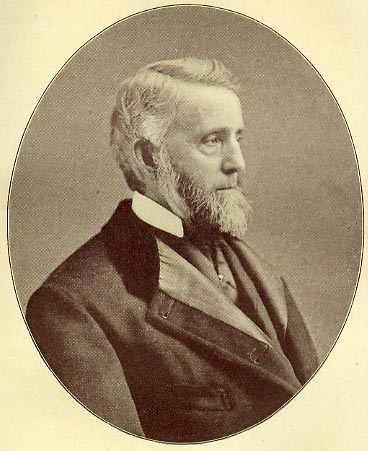
William Pryor Letchworth was born to a Quaker family in Brownville NY on May 26, 1823. The fourth of eight children, William grew up in a family that valued hard work, charity, and the development of the intellect. (See the Letchworth Genealogy)
As a young child William and his family moved to Sherwood, just outside of Auburn. At the age of fifteen he began his career in the saddlery and hardware business, as a clerk in the firm of Hayden & Holmes. Just ten years later he became a partner in the firm of Pratt & Letchworth of Buffalo New York which he built into a successful "malleable iron" business. (See a 1872 description of his business)
Hard work took a toll on the young businessman. Letchworth, now in his middle thirties, began to look for an escape from the burdens of business and city life. When he stepped from the train to join other tourists gazing from the great Portage Bridge of the Genesee, his search was over. The Valley that stretched before him would become his home and his life's work. (See Image of Letchworth as Young Man)
In 1859 he made his first purchase of land near the Portage Falls and began his work on making his Glen Iris Estate a special place. He enlisted the services of the famous landscape artist William Webster to design winding paths and roadways, rustic bridges, glistening "lakes" and a sparkling fountain. Soon the glories of nature returned to the place the Senecas had called Sehgehunda.
Letchworth also worked to preserve the native history of the Valley. He created the "Council Grounds" on a bluff above the Glen Iris, and moved the ancient Seneca Council House and a Gardeau cabin to the Grounds. He eventually built a Museum to house his growing collection of artifacts. Most importantly, he allowed the famous Mary Jemison to be buried on the Council Grounds, and erected a statue in her honor. For his work the Seneca People honored him with the name Hai-wa-ye-is-tah, "he who does the right thing."
Letchworth never married, but his Estate was always alive with his relatives and friends. His visitors explored the natural beauty of the Glen as they shared the poetry, literature, and art their host so much enjoyed. Able to retire from business in 1871 at the age of 48, Letchworth looked forward to a peaceful life at the Glen Iris. (See Letchworth with family at Glen Iris)
But Letchworth would soon find another calling. Perhaps it was his Quaker heritage, his "sensitive constitution", or the need to repay society for his financial success that led him to look for ways to help his fellow man. Pressured to run for the State Legislature, he instead accepted an appointment to the New York State Board of Charities in 1873. (See Glimpse of his humanitarian work.)
It would be in the field of social reform that Letchworth true legacy was found. Using only his own funds, he traveled Europe and the United States to study the treatment of epileptics and poor children. He wrote extensively on the two subjects, and slowly pushed New York State forward in creating institutions and systems to care for the helpless of society. The development of epileptic centers and the foster care system can be attributed to him. (See a list of his Works)
Mr. Letchworth retired from the State Board of Charities in 1896. But his work was far from over. From his study in the Glen Iris he continued his writing and correspondence on numerous topics relating to social care, and he continued to oversee the workings of his Estate.
But starting in 1898, the very existence of his beloved Glen Iris was threatened. The Genesee River Company was formed, which desired to tap the Genesee River as a source of power and profit. A dam would be built just south of the Portage Bridge, and the water used to generate electricity. Although Letchworth had planned to turn the Glen Iris into an orphanage, he knew that it would not be protected. In 1906 he offered the Glen Iris and his thousand acres to the State of New York as a public park. Letchworth State Park was born in 1907, saving the lands of the Glen Iris Estate forever. (More on Saving the Glen Iris)
Letchworth had life use of the Glen Iris, and lived in his beloved valley until his death on December 1, 1910. As he wished, he was buried at Forest Lawn Cemetery in Buffalo NY with a plain slab of stone from the Lower Falls of the Genesee marking his final resting place.
Tom Cook
For more information see Larned's and Beale's biographies and a variety of pages in our "Pieces of the Past"